Taiwan
 From Rationalwiki
From Rationalwiki 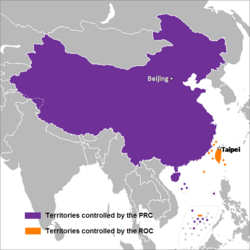
“”I am saddened to see these scenes of violence against unarmed protesters [by the PRC in Hong Kong] and hope that Taiwan can continue to serve as a beacon of democracy for those who seek freedom.
|
| —Tsai Ing-wen, November 2019[1] |
The Republic of China (ROC), most commonly known as Taiwan, is a de facto state (or de jure rogue province of China) situated on an island with the same name in East Asia adjacent to mainland China. Its population is primarily of ethnic Han Chinese descent, who settled on the island from neighboring Fujian in the 17th century.
The Republic of China, not to be confused with the People's Republic of China (PRC), de jure claims to be the legitimate government over all of China, including both the mainland and Taiwan. However, the Taiwanese government today, especially the Democratic Progressive Party![]() (DPP), with no realistic chance of taking the mainland, is content to enjoy de facto independence. The People's Republic, however, feels otherwise. For its part, it also claims authority over the island of Taiwan and does not recognize its government as legitimate. Despite increasingly cordial ties between the two states in the 1990s and 2000s, relations have taken a major hit in recent years due to the rise of independence-leaning politics in Taipei and Beijing's increasingly aggressive diplomatic policy as it grows to rival other major powers.
(DPP), with no realistic chance of taking the mainland, is content to enjoy de facto independence. The People's Republic, however, feels otherwise. For its part, it also claims authority over the island of Taiwan and does not recognize its government as legitimate. Despite increasingly cordial ties between the two states in the 1990s and 2000s, relations have taken a major hit in recent years due to the rise of independence-leaning politics in Taipei and Beijing's increasingly aggressive diplomatic policy as it grows to rival other major powers.
The island of Taiwan was home to indigenous Austronesian![]() peoples for several thousand years before the Dutch began colonizing the island.[2] That event kicked off a massive wave of Chinese immigration from the mainland. After the Qing dynasty overtook the Ming dynasty in the 17th century, Ming loyalists fled to Taiwan and established the Tungning Kingdom[3] in a move that should probably sound somewhat familiar. Eventually, the Qing integrated Taiwan, but lost it to the Empire of Japan in 1895. The island remained in Japanese hands until World War II, when the Republic of China retook it after the Japanese surrendered. The Chinese Civil War between nationalists and communist forces immediately set in once more, and communist victory over most of China saw the Kuomintang (KMT) nationalist forces flee to Taiwan.
peoples for several thousand years before the Dutch began colonizing the island.[2] That event kicked off a massive wave of Chinese immigration from the mainland. After the Qing dynasty overtook the Ming dynasty in the 17th century, Ming loyalists fled to Taiwan and established the Tungning Kingdom[3] in a move that should probably sound somewhat familiar. Eventually, the Qing integrated Taiwan, but lost it to the Empire of Japan in 1895. The island remained in Japanese hands until World War II, when the Republic of China retook it after the Japanese surrendered. The Chinese Civil War between nationalists and communist forces immediately set in once more, and communist victory over most of China saw the Kuomintang (KMT) nationalist forces flee to Taiwan.
The nationalists, now only mostly left with Taiwan, subsequently established an authoritarian one-party state on the island. In 1949, martial law was declared after the brutal suppression of political dissidents in the aftermath of the February 28 incident![]() . This period, now known as the White Terror
. This period, now known as the White Terror![]() , lasted almost 40 years, before ending in 1987. During the mid-1990s, Taiwan managed to reform away from its former military dictatorship into the democracy it is today. However, there was never a proper truth and reconciliation commission, except for a civilian reparations fund.
, lasted almost 40 years, before ending in 1987. During the mid-1990s, Taiwan managed to reform away from its former military dictatorship into the democracy it is today. However, there was never a proper truth and reconciliation commission, except for a civilian reparations fund.
History[edit]
Colonization by the Chinese and Europeans[edit]
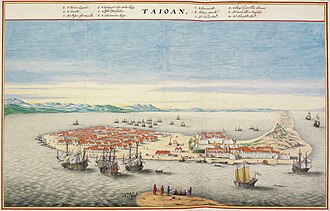
Taiwan is the linguistic homeland (Urheimat![]() ) of Austronesian languages spoken by the indigenous people of Taiwan, Polynesians, Micronesians, most Malaysians, Indonesians, Filipinos, some mainland Southeast Asians such as the Cham people in Vietnam, and the people of Madagascar.[4] Today, they comprise about 2% of Taiwan's population and face significant social challenges.[5]
) of Austronesian languages spoken by the indigenous people of Taiwan, Polynesians, Micronesians, most Malaysians, Indonesians, Filipinos, some mainland Southeast Asians such as the Cham people in Vietnam, and the people of Madagascar.[4] Today, they comprise about 2% of Taiwan's population and face significant social challenges.[5]
As an island close to the massive economic power of Imperial China, Taiwan naturally became the subject of extreme interest by European colonizers. The Dutch, who knew Taiwan as "Formosa", established Fort Zeelandia on the southern edge of Taiwan, using it as an international business and trade hub.[6] The Dutch later expanded their rule to encompass most of the south part of the island. Not to be outdone, Spanish colonizers took the island's northern side and built two major settlements: Fort Santo Domingo and San Salvador.[7] The Dutch managed to expel the Spanish from the island after the Eighty Years War. They decided to solidify their hold on Taiwan by providing incentives to attract Chinese immigration to Dutch Taiwan.[8] The Dutch and Chinese cooperated against the indigenous Taiwanese for a long time, but the Dutch eventually pissed off the Chinese colonists by raising taxes.
Meanwhile in mainland China, one of the bloodiest wars in the world was drawing to a close. Manchu tribal peoples from the north had successfully taken advantage of an internal rebellion against the Ming dynasty, sweeping south in their enemy's moment of weakness to begin conquering large swathes of Chinese territory.[9] In 1644, the Manchu seized Beijing and declared the Qing dynasty. However, southern China didn't go along with this, and Ming loyalists from the region fled to Taiwan, hoping the island would become a staging point for a reconquest of China. The Dutch naturally objected to this, but they were defeated militarily by Ming loyalist general Zheng Chenggong,[8] who then established the Tungning Kingdom with himself as ruler in 1662.
This so-called Tungning Kingdom did not last very long. Around two decades after Zheng died, the Qing invaded the island and defeated its navy in a single decisive engagement. Taiwan surrendered to Chinese rule almost immediately after.[10]
Qing rule[edit]

As it existed during the high point of European imperialism, the Qing had the dubious honor of having to constantly defend Taiwan against foreign encroachments. The United Kingdom, for instance, considered trying to seize Taiwan from the Qing as early as 1840, and later launched attacks against the island during the First Opium War.[11] During the same conflict, some British troop transports shipwrecked off the coast of Taiwan, and the Qing had most of them, some 300 people, either beheaded or slowly killed through maltreatment.[12]
The French also tried to invade Taiwan during the Sino-French War. Once again, the Qing successfully defended the island, a significant and embarrassing defeat to the European power.[13]
Taiwan also presented the Qing with a variety of domestic problems. There were over a hundred rebellions against Qing rule in Taiwan, which occurred so frequently that the Chinese came up with a pithy saying: "every three years an uprising; every five years a rebellion".[14] The waters around Taiwan were perpetually infested with pirates who posed an extreme threat to the Chinese navy,[15] and locals were far from suppressed.
When aborigines attacked a American ship in 1867, the U.S. launched a punitive invasion of Taiwan. However, it ended with a humiliating American failure, as the natives successfully used guerrilla tactics to exhaust the US Marines and eventually kill their commander.[16]
Japanese rule[edit]
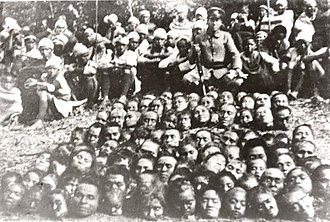
Despite its valiant efforts, the Qing dynasty eventually lost control of Taiwan. The conflict had long been brewing between China and Japan over hegemony of Korea, and tensions finally resulted in outright war in 1894.[17] Although the Japanese were (of course) vastly outnumbered by the Chinese, they possessed a much more modern army and navy. In about a year, Japan managed to invade much of northern China and force an end to the war. China unhappily signed the Treaty of Shimonoseki, ceding Taiwan and several ports to Japan and conceding Korea's independence under Japanese influence.[18]
Pro-Qing leaders briefly attempted to resist Japanese rule by declaring independence as the Republic of Formosa, but Japan quickly quelled the movement.[19] There would be several more uprisings against the Japanese, all unsuccessful.
Japanese overlordship of Taiwan actually benefited the island's people in several ways, mostly due to Japan's intense campaign to modernize Taiwan's infrastructure. Japan built railroads, established Taiwan's first sanitation systems, and installed an official education system.[20] However, as one might expect, all was not sunshine and roses under the Japanese Empire. Japan used Taiwan to benefit its own industrialization by effectively outsourcing agricultural production to its island colony.[21] Taiwanese workers were thus forced into farming cash crops like rice and sugar. Meanwhile, Japan launched a series of bloody suppression campaigns against Taiwan's locals, who resented being considered by their colonial overlords as third-class citizens.[22] Japan also used its education system to assimilate the Taiwanese into Japanese culture, eventually expanding that effort by banning the Chinese language and suppressing Taiwanese culture.[23]
Japan's exploitation of Taiwan climaxed during the Second World War. Japan used Taiwan as a base to attack China, and the Japanese military forced thousands of Taiwanese women into sexual slavery, euphemistically calling them "comfort women".[24]
A little trouble in big China[edit]
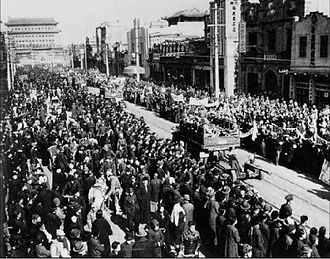
“”I would rather mistakenly kill 1,000 innocent people than allow one Communist to escape.
|
| —Chiang Kai-shek[25] |
Over in mainland China, the Xinhai Revolution of 1911-12 overthrew Qing imperial rule and established the Republic of China (ROC).[26] However, Republican rule was marred by a series of conflicts, most notably the Chinese Civil War (from 1927) between the nationalist party Kuomintang (KMT), led by General Chiang Kai-shek, and the Communist Party, led by Mao Zedong,[27] and the Second Sino-Japanese War (from 1937), when Japanese forces invaded.
The civil war was temporarily put aside as both parties fought the Japanese under an uneasy alliance,[28] and the Sino-Japanese War subsumed into the Second World War. Chiang Kai-shek represented the ROC in talks with allied leaders coordinating action against Japan and restitutions they would seek, leading to the Cairo Declaration of 1943, which included a statement that "all the territories Japan has stolen from the Chinese, such as Manchuria, Formosa [Taiwan], and The Pescadores, shall be restored to the Republic of China",[29] a claim notably absent from the official surrender document, the 1952 Treaty of San Francisco.[30]
After the fall of the Japanese Empire, KMT forces entered Taiwan, annexing it to the ROC, according to the Cairo Declaration. This was somewhat controversial within the island itself, since this "reunification" of China and Taiwan placed the island under a nationalist regime which it had never been subjected to. Relations between Mandarin-speaking ROC troops and Taiwanese locals (most of whom spoke Taiwanese Hokkien) became increasingly strained, mainly because the ROC was more interested in stripping Taiwan's assets to finance the civil war in China (which had resumed after Japan's surrender) than in actually governing Taiwan. An altercation between ROC soldiers and a cigarette vendor in 1947 resulted in a bloody crackdown known as the 228 Incident and the declaration of martial law within Taiwan.[31] Estimates of the death toll range from 5,000 to a whopping 28,000.[32]
The Chinese Civil War ended with a total Communist Party victory on the mainland in 1949, in which the Communist Party took decisive control of the mainland, establishing the People's Republic of China (PRC). Together with its armed forces, Chiang Kai-shek and the KMT government retreated to Taiwan, where they established Taipei as the temporary capital of the ROC (it has remained the capital ever since, however).[33] Although Red China planned to take Taiwan, the Korean War broke out before they could, pitting them against the United States. President Harry Truman ordered the U.S. Navy into the Taiwan strait to protect the nationalists from any communist assault. Mao was forced to give up on the assault rather than face the technologically superior U.S. military.[34]
That has basically been the status of Taiwan ever since. Both Chinese regimes regarded themselves as the rightful government of both territories, pledging to reunify them in due course, and both officially still maintain this "One China policy".
Kuomintang dictatorship[edit]
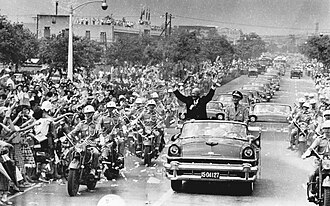
The first years of KMT rule on Taiwan were grim. Martial law dragged on for decades, and the KMT used it to impose harsh political suppression measures, massacring tens of thousands of Taiwanese out of fear that they might be communists or liberals.[35] As many as 140,000 dissidents may have been murdered by Taiwan's dictatorship.[36]
Meanwhile, the United States had decided due to the Korean War that maintaining Taiwan's independence was a critical method of containing Communist China's aggression. The U.S. signed the Sino-American Mutual Defense Treaty in 1955, promising to aid Taiwan if China tried anything funny.[37] That commitment was tested during the First Taiwan Straits Crisis, when the PRC began artillery bombardments of some ROC-controlled islands. The U.S. Congress retaliated by passing the "Formosa Resolution", permitting President Dwight Eisenhower to use any military means necessary to protect Taiwan from Chinese aggression.[38] China backed down due to the real threat of war with the United States, but they started bombing Taiwan again in 1958. The PRC hoped the U.S. would be distracted by its military activities in Lebanon. Eisenhower was able to organize a resupply of the ROC's military, convincing the Chinese that American commitment was still there.[38] Communist China once again backed down.
As time went on, Taiwan's economy began to dramatically improve. The island's economic production was limited since the Japanese considered it a giant farm and nothing else. The ROC's main challenge was thus transforming Taiwan from an agrarian society to one built on manufacturing. Taiwan started its economic development by focusing on textile and apparel, which had formed the backbone of Britain's early industrialization.[39] The government then used state-owned banks to attract foreign capital and help would-be factory owners get off the ground. Production soon outpaced domestic demand, and Taiwan had to offer incentives for other countries to buy Taiwanese-made products. The result was an economic boom that allowed Taiwanese manufacturing to branch out into other industries such as consumer electronics.[39] Taiwan bought licenses from Japan to build radios and televisions, then sold them to U.S. markets.[39] Much later, Taiwan got into making semiconductors and computers. Unfortunately, while the economy was taking off, Taiwan did not liberalize for a long time. The KMT forbade the creation of any new parties, so competitive elections were impossible.[40]
Becoming a democracy and entering the modern era[edit]
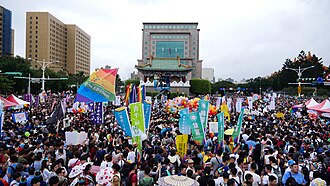
Chiang Kai-Shek kicked the bucket in 1975, having maintained until his dying day that he would one day rule the Chinese mainland. Reforms only began very slowly. The government cracked down on a pro-democracy protest in 1979, but this time the event managed to unify the KMT's opposition against its dictatorship.[41] The Democratic Progressive Party managed to organize in 1986, becoming the main opposition organization in Taiwan.[42] Taiwan's government lifted martial law in 1987, but quickly enacted a security law to ensure dissidents wouldn't get too excited.[43]
Much of this was motivated by Taiwan's dismay at the United States' warming relationship with the People's Republic, which had finally killed the Taiwanese dream of one day unifying China under the nationalist rule.[44] Once that objective was tossed aside, there was no need for such a violent military dictatorship. Taiwan finally held its first democratic election in 1989.[45] The KMT finally lost power in 2000, when its candidate lost the election. Nevertheless, the KMT returned to power in a democratic manner during the 2000s and 2010s.
Recently, under the DPP government since 2016, Taiwan started to assert a separate identity from China. The state acknowledged "Taiwan" as one of its official names, but did not give up on the title "Republic of China".[46] Tsai Ing-wen of the DPP is the current president of Taiwan.[47]
In 2019, Taiwan became the first country in Asia to legalize same-sex marriage, even though a referendum from the previous year opposed it.[48] It now holds LGBT pride parades attended by people from all over the region.[49]
International relations[edit]

One China policy[edit]
“”Taiwan is part of the sacred territory of the People's Republic of China. It is the lofty duty of the entire Chinese people, including our compatriots in Taiwan, to accomplish the great task of reunifying the motherland.
|
| —Preamble to the Constitution of the PRC[50] |
As with the two Koreas, the two Chinas were a major political football in the early decades of the Cold War. Both the ROC and the PRC maintained a "one China policy", as did their diplomatic allies, who recognized one or the other as the true government of China. Of course, the Soviet Union and Communist Bloc backed the PRC, while the Western powers viewed "Red China" as a bastard regime and favored the ROC instead.
The ROC (i.e. Taiwan) initially represented China within the United Nations.[51] Meanwhile, communist powers repeatedly petitioned the U.N. General Assembly to expel the ROC and recognize the PRC instead.[52] However, things changed when U.S. President Richard Nixon decided to start a diplomatic rapprochement with the PRC. The U.S. did not prevent the United Nations from raising the question of who should have the Chinese Security Council seat. As a result, the body successfully passed a resolution expelling Taiwanese diplomats and admitting those of Communist China. Taiwan's humiliation was cemented in 1972, when Nixon opened relations with the PRC, and the U.S. officially recognized the PRC rather than the ROC as China's government. Taiwan wasn't happy about this, and when U.S. officials arrived in Taipei to explain that they would be severing relations with Taiwan, an angry mob attacked their car.[51]
The PRC has aggressively pursued its interpretation of the One China policy in all its international relations, only establishing diplomacy with countries that recognize Taiwan as a province of China and refusing to deal with countries that maintain official diplomatic ties with the ROC.[53] Meanwhile, China's significance as a major political and economic power has continued to grow. As a result of the PRC's hostile stance on the issue, only 12 member states plus the Holy See still maintain official diplomatic relations with Taiwan.[54]
Within Taiwan, the One China policy is a thorny issue. Despite the official position, reunification with China has largely been a pipe dream. Reunification under the ROC is impossible, and annexation into the PRC is unthinkable. Many still support the principle of the ROC as a Chinese government. The Taiwanese independence movement has gained significant popularity since the democratization of Taiwan in the 1980s and 1990s, seeking a distinct national identity for Taiwan. There is also an older tradition of Taiwanese nationalists who view the KMT rule in Taiwan as an illegal occupation little different from the Japanese imperialism which preceded it.
Internationally, the country is left in an awkward diplomatic stalemate. The PRC has repeatedly made it clear that it will tolerate (without recognizing) ROC rule within Taiwan as long as the ROC maintains a One China policy and that a declaration of Taiwanese independence would be seen as a direct act of aggression.
Currently, 13 countries recognize the ROC over the PRC, but most are small island countries with few people.[55]
Relations with the United States[edit]
.jpg)
Although the two countries have no official diplomatic ties, the United States is still one of Taiwan's primary geopolitical allies. In 1979, the U.S.'s bilateral defense pact with Taiwan, which was maintained throughout much of the Cold War, was repealed and replaced with the Taiwan Relations Act, which declares that the U.S. does not recognize the "Republic of China" but rather maintains ties with "Authorities in Taiwan"; it also states that Taiwan is of "grave concern" to the United States.[56] Finally, it claims the U.S.'s right to continue selling defensive weapons to Taiwan.
You're not alone if most of that sounds pretty damn ambiguous. The United States' relationship with Taiwan is often defined as "strategic ambiguity", trying to ensure that the PRC isn't confident enough to attack Taiwan and that Taiwan is also not confident enough to officially declare independence.[57] It is a deliberate attempt to maintain the fog of war to ensure that no one gets any funny ideas and starts shooting.
With President Donald Trump's recent trade conflict with the People's Republic and the subsequent souring of relations, the end of "strategic ambiguity" may be nigh. Congressional testimony from a Department of Defense official in February 2019 raised some eyebrows, as the official's language went significantly beyond the text of the Taiwan Relations Act when he spoke about the U.S.'s relationship with the island.[58] The Secretary of Defense did nothing to alleviate questions raised by the statements. Throughout the rest of 2019, it seemed as if Trump intentionally raised the heat in the Taiwan straits, breaking from the Obama administration's policies. U.S. naval vessels sailed through the Taiwan strait six times that year, and Trump seemed to be encouraging Taiwan to buy more weapons from the U.S., including F-16 fighters.[59] Trump's friendliness to Taiwan was an early fixture of his presidency; shortly after Tsai Ing-wen's election victory, President-elect Trump called to congratulate her,[60] an action sparked an official protest from Beijing.
Culture[edit]
Like some other countries in Asia, Taiwan absorbed some western influences during the 20th century, but retained very strong elements of its traditional culture. It did not undergo the Cultural Revolution inflicted on the People's Republic. Buddhism, Taoism, Confucianism, folk beliefs, feng shui, and Chinese astrology continue to be important religious and cultural influences.
Mandarin is the official language of instruction and the primary language used in the media, but many Taiwanese speak Hokkien as their vernacular language. In the 20th century, Mandarin was heavily promoted by the KMTh, who tried to eradicate Hokkien and other native languages as much as possible. This led to a backlash from Taiwanese nationalists who favor giving Hokkien more prominence. The written language is traditional Chinese, unlike the simplified Chinese used in mainland China, which was adopted in the PRC under Chairman Mao. However, Taiwan does use Hanyu Pinyin![]() , the official romanization system for Standard Mandarin Chinese first introduced by the PRC.[61]
, the official romanization system for Standard Mandarin Chinese first introduced by the PRC.[61]
Sun Yat-sen, a leader in the Xinhai Revolution and early days of ROC rule in mainland China, is revered as a national hero despite never having set foot in Taiwan. Chiang Kai-shek had been similarly honored (at least officially) during the 20th century, but modern views of him tend to be more circumspect.
Gallery[edit]
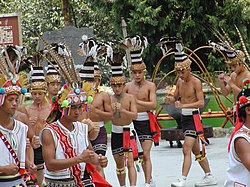
Indigenous Taiwanese in traditional garb
_and_Ma_Kong_(DDG-1805)_shipped_in_Zhongzheng_Naval_Base_20130504b.jpg)
Two Taiwanese destroyers, bought from the U.S.
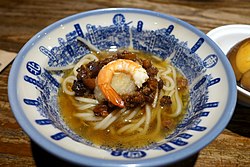
Danzi noodles
Praying at the Lungshan Temple
See also[edit]
- Chinese-owned US debt
- Chinese Civil War
- Imperial China
- Kashmir
- Rape of Nanjing — Japanese atrocities in the former capital of the Republic of China during World War II
- Tibet
References[edit]
- ↑ Taiwan president condemns Hong Kong authorities for firing at protesters. Taiwan News.
- ↑ See the Wikipedia article on Taiwanese indigenous peoples.
- ↑ See the Wikipedia article on Kingdom of Tungning.
- ↑ See the Wikipedia article on Austronesian languages.
- ↑ Who are the Taiwanese Aboriginals?. Guide to Taipei.
- ↑ See the Wikipedia article on Fort Zeelandia (Taiwan).
- ↑ See the Wikipedia article on Spanish Formosa.
- ↑ 8.0 8.1 How Taiwan Became Chinese: Dutch, Spanish, and Han Colonization in the Seventeenth Century, by Tonio Andrade (2008). Not Even Past.
- ↑ 5 Of The 10 Deadliest Wars Began In China. Business Insider.
- ↑ Copper, John F. (2000). Historical Dictionary of Taiwan (Republic of China) (2nd ed.). Lanham, Md.: Scarecrow Press. p. 10. ISBN 9780810836655. OL 39088M.
- ↑ Shih-Shan Henry Tsai (2009). Maritime Taiwan: Historical Encounters with the East and the West. Routledge. pp. 66–67. ISBN 978-1-317-46517-1.
- ↑ See the Wikipedia article on Nerbudda incident.
- ↑ See the Wikipedia article on Battle of Tamsui.
- ↑ Skoggard, Ian A. (1996). The Indigenous Dynamic in Taiwan's Postwar Development: The Religious and Historical Roots of Entrepreneurship. M.E. Sharpe. ISBN 9781563248467. OL 979742M. p. 10
- ↑ Qing-era Chinese pirates. Facts and Details.
- ↑ See the Wikipedia article on Formosa Expedition.
- ↑ First Sino-Japanese War. Britannica.
- ↑ Treaty of Shimonoseki. Britannica.
- ↑ Morris, Andrew (2002). "The Taiwan Republic of 1895 and the failure of the Qing modernizing project". In Corcuff, Stéphane (ed.). Memories of the future: national identity issues and the search for a new Taiwan. M.E. Sharpe. pp. 3–24. ISBN 978-0-7656-0792-8.
- ↑ Chou, Chuing Prudence; Ho, Ai-Hsin (2007). "Schooling in Taiwan". In Postiglione, Gerard A.; Tan, Jason (eds.). Going to school in East Asia. Greenwood Publishing Group. pp. 344–377. ISBN 978-0-313-33633-1.
- ↑ The History of Taiwan. The Republic of China Yearbook 2001. Government Information Office. 2001.
- ↑ Tierney, Robert (2010). Tropics of Savagery: The Culture of Japanese Empire in Comparative Frame. University of California Press. pp. 8–9. ISBN 978-0-520-94766-5.
- ↑ Kominka Movement. Encyclopedia Taiwan. Archived.
- ↑ Protesters demand justice from Japan on 'comfort women' (update). Focus Taiwan.
- ↑ Barnouin, Barbara and Yu Changgen. Zhou Enlai: A Political Life. Hong Kong: Chinese University of Hong Kong, 2006. p. 38
- ↑ The 1911 Xinhai Revolution. Alpha History.
- ↑ The Chinese Civil War. Alpha History.
- ↑ See the Wikipedia article on Second United Front.
- ↑ See the Wikipedia article on Cairo Declaration.
- ↑ See the Wikipedia article on Treaty of San Francisco.
- ↑ The 228 Incident Still Haunts Taiwan. The Diplomat.
- ↑ See the Wikipedia article on February 28 incident.
- ↑ See the Wikipedia article on Republic of China retreat to Taiwan.
- ↑ Bush, Richard C. (2005). Untying the Knot: Making Peace in the Taiwan Strait. Brookings Institution Press. ISBN 0-8157-1288-X
- ↑ White Terror exhibit unveils part of the truth. Taipei Times.
- ↑ Taiwan president apologises for 'white terror' era. Asia One.
- ↑ See the Wikipedia article on Sino-American Mutual Defense Treaty.
- ↑ 38.0 38.1 The Taiwan Straits Crises: 1954–55 and 1958. US State Department.
- ↑ 39.0 39.1 39.2 Inside the Taiwan Miracle. Taiwan Today.
- ↑ Chao, Linda; Ramon Hawley Myers (1997). Democracy's new leaders in the Republic of China on Taiwan. Hoover Press. p. 3. ISBN 978-0-8179-3802-4.
- ↑ See the Wikipedia article on Kaohsiung Incident.
- ↑ Democratic Progressive Party
- ↑ Taiwan Ends 4 Decades of Martial Law. New York Times.
- ↑ Why Taiwan ended one-party rule and embraced democracy. South China Morning Post.
- ↑ Path to democracy. BBC News.
- ↑ Taiwan party asserts separate identity from China. USA Today.
- ↑ See the Wikipedia article on Tsai Ing-wen.
- ↑ Taiwan's gay marriage law victory not an obvious win for its President. Lowy Institute.
- ↑ Taiwan more than ever a beacon for LGBT Asians after gay marriage law’s passage. South China Morning Post.
- ↑ Text of the Chinese Constitution.
- ↑ 51.0 51.1 The Long Fall of Taiwan. The Atlantic.
- ↑ See the Wikipedia article on United Nations General Assembly Resolution 2758.
- ↑ Henckaerts, Jean-Marie (1996). The international status of Taiwan in the new world order. Martinus Nijhoff Publishers. pp. 96–97. ISBN 978-90-411-0929-3.
- ↑ Solomon Islands Ends Diplomatic Ties with Taiwan, Stands by China. Wall Street Journal.
- ↑ Australia-Taiwan relationship
- ↑ See the Wikipedia article on Taiwan Relations Act.
- ↑ Unloved but essential: 40 years on, the Taiwan Relations Act remains flexible, durable and effective. South China Morning Post.
- ↑ The end of strategic ambiguity on Taiwan?. The Hill.
- ↑ U.S. Military Support for Taiwan: What’s Changed Under Trump?. Council on Foreign Relations.
- ↑ Trump-Taiwan call: China lodges protest. BBC News.
- ↑ Shih Hsiu-Chuan (18 Sep 2008). "Hanyu Pinyin to be standard system in 2009". Taipei Times. p. 2.
Categories: [Disputed countries] [China] [Taiwan] [International relations]
↧ Download as ZWI file | Last modified: 11/08/2025 05:51:36 | 247 views
☰ Source: https://rationalwiki.org/wiki/Taiwan | License: CC BY-SA 3.0
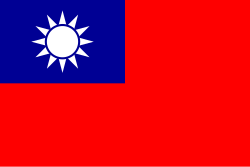
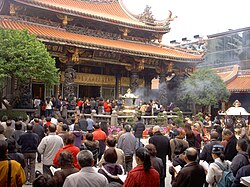
 KSF
KSF